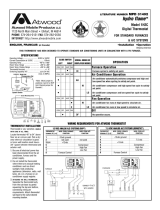
2
TABLE OF CONTENTS
INTRODUCTION ..................................................................................................................................................................2
DOCUMENT SYMBOLS.......................................................................................................................................................2
IMPORTANT SAFETY INSTRUCTIONS ............................................................................................................................3
A. Recognize Safety Information ...................................................................................................................................3
B. Understand Signal Words ..........................................................................................................................................3
C. Supplemental Directives ............................................................................................................................................ 3
D. General Safety Messages .........................................................................................................................................3
SPECIFICATIONS ................................................................................................................................................................4
A. Table - Unit Data ........................................................................................................................................................4
B. Roof Requirements ....................................................................................................................................................4
C. Table - Air Distribution Duct Sizing & Design ............................................................................................................. 5
INSTALLATION INSTRUCTIONS .......................................................................................................................................5
A. Choosing Proper Location For Unit ...........................................................................................................................5
B. Roof Preparation .......................................................................................................................................................6
C. Air Distribution Duct Sizing & Design ........................................................................................................................7
D. Wiring Requirements .................................................................................................................................................8
E. Choosing Thermostat Location ..................................................................................................................................8
F. Thermostat Installation .............................................................................................................................................9
G. Placing Unit On Roof .................................................................................................................................................9
H. Installation Preparation ............................................................................................................................................ 10
I. LCD SZ System Low Voltage Wire Connections .....................................................................................................12
J. Upgrading from Bi-Metal Thermostat to SZ LCD Thermostat .................................................................................12
K. Installing Return Air Cover .......................................................................................................................................13
GENERAL INFORMATION ................................................................................................................................................14
A. Frost Formation On Cooling Coil .............................................................................................................................14
B. Heat Gain ................................................................................................................................................................14
C. Condensation ..........................................................................................................................................................14
D. Air Distribution .........................................................................................................................................................14
WIRING DIAGRAMS ..........................................................................................................................................................15
A. Simple RV Wiring Diagram ...................................................................................................................................... 15
B. Unit Wiring Diagrams ...............................................................................................................................................16
DOCUMENT SYMBOLS
Indicates additional information that is NOT related
to physical injury.
Indicates step-by-step instructions.
INTRODUCTION
This air conditioner/heat pump (hereinafter referred to as “unit” or “product”) is designed and intended for installation on the
roof of a Recreational Vehicle (hereinafter referred to as RV) during the time it is manufactured.
Read these instructions and highlight the appropriate steps for your particular procedure before starting the installation.
This unit can be installed by one person with brief help from additional personnel. Use these instructions to ensure a properly
installed, and properly functioning product.
Dometic Corporation reserves the right to modify appearances and specications without notice.

















